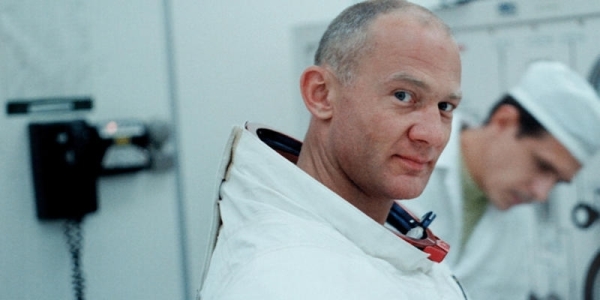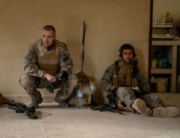![]() Early on in this spectacular, ultimately triumphant documentary, we get a sense of just how enormous an undertaking the Apollo 11 mission in 1969 really was. One of the first shots is of the launch area at the Kennedy Space Center in Florida on the evening before liftoff, where the giant rocket that will carry the Columbia spacecraft out of Earth’s atmosphere looms enormous. Then on the morning of the fateful launch, we get a long look inside the NASA facility itself, including the vast and heavily populated chamber that serves as mission control.
Early on in this spectacular, ultimately triumphant documentary, we get a sense of just how enormous an undertaking the Apollo 11 mission in 1969 really was. One of the first shots is of the launch area at the Kennedy Space Center in Florida on the evening before liftoff, where the giant rocket that will carry the Columbia spacecraft out of Earth’s atmosphere looms enormous. Then on the morning of the fateful launch, we get a long look inside the NASA facility itself, including the vast and heavily populated chamber that serves as mission control.
In what becomes a recurring device throughout, an onscreen counter ticks away the hours, minutes, and seconds left until the next stage of the mission. While we wait for stage one, aka the launch, we catch our first glimpse of astronauts Neil Armstrong, Buzz Aldrin, and Michael Collins as they go through their final checks. A close-up of each is accompanied by an almost subliminal montage encapsulating scenes of flight tests and family life, which provides just enough information for us to feel personally invested in these men as they prepare to do something extraordinary—and risky.
The film consists of previously unseen footage gathered by NASA and the National Archives, which director Todd Douglas Miller has shaped into what often feels like a thriller, thanks to the relatively daring choice not to include a framing device or talking heads. For the most, the point of view is that of the astronauts or those in mission control. At no point is there the sense that we are looking back on events that will inevitably be successful. Instead, they unfold before our eyes, and the resulting experience is never short of riveting.
Like many thrillers, the footage has been shaped so there is minimal downtime in between the different stages of the mission, which consist of escaping Earth’s atmosphere, flying to the moon, landing on the lunar surface, and the return trip. At each step along the way, there is a graphic sequence beforehand showing exactly what the astronauts are attempting to do. On the one hand, the initial explanation prevents whatever follows from ever becoming too confusing, but even when things go by the proverbial book, they tend to be compelling in their own right. For example, nothing really compares to watching the moon’s surface grow larger before our eyes as the Columbia races towards it.
Meanwhile, when things do not go as planned—which happens surprisingly often—it feels especially suspenseful. The filmmakers also sifted through more than 10,000 hours of never-before-heard audio recordings from the mission, and what is especially miraculous is how unflappable Armstrong, Aldrin, and especially Collins appear throughout. We are constantly reminded of the narrow margin of error that the astronauts were working with, especially when it came to fuel. They could not afford for too many things to go wrong, so their composure whenever something did is especially impressive.
Despite being crafted from archived footage, Apollo 11 feels refreshingly modern, thanks to moments of levity that seem like something out of a seminal Spielberg movie. In particular, we discover the dry wit of Collins and Aldrin, with the former at one point responding to mission control’s complaint that they’ve lost track of his vital signs; he promises to let them know if he stops breathing.
Miller also leverages another cinematic device, the split screen, to tell the narrative dynamically. In the lead up to the launch, viewers see what audiences back in 1969 saw on their television screens: the astronauts slowly making their way via van to the shuttle. But thanks to the use of split screen, we learn that behind-the-scenes, there was a potential disaster in the making going on simultaneously: engineers were desperately trying to repair a tube supplying liquid nitrogen to the shuttle. Later, during Armstrong and Aldrin’s inaugural walk upon the lunar surface, there’s a side-by-side look at it through crisp, large-format 65mm film and grainier, lower-quality stock. The former looks like from the history books, while the other comes across as somehow more immediate, as if one of the astronauts were walking around with an 8mm camera.
The film also boasts compelling sound design: moments of foreboding quiet will be suddenly interrupted by a beep within the capsule that seems accompanied by several exclamation points in a row. In addition, the synthesizer-driven soundtrack by Matt Morton results in a unique sense of atmosphere at key moments—the lunar landing itself has a downright trippy feel.
At just 90 or so minutes, Apollo 11 is a lean thrill ride. Despite centering on events that nearly all of us know ended well, it has a sense of immediacy translates into suspense, and if nothing else, it has eye-popping cinematography that doesn’t just apply to the space scenes. Some of the most rousing sights are from the morning of the launch, when throughout Cape Canaveral, people of all stripes gather together with anticipation. Scenes like these and the inspirational finale are a potent reminder that when we put aside our differences and rally around a common cause, we can potentially change the course of history as well as bring out the best in one another. During these especially divisive times, that’s a message we all need.

















Leave A Comment